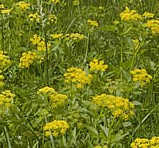 The moisture conditions in a rain garden vary and four regions can be identified: areas with 1. shallow water most of the time, 2.wet soil with occasional standing water, 3. moist but not wet soil, and 4. dry, well-drained soils. Each area has plants that will thrive or tolerate the moisture regime but few plants do well in all of them. For color in spring, the following plants are good choices for wet areas with occasional standing water. Although none tolerate permanent standing water, most will do well in moist soil as well as wet and this has been noted in the descriptions.
The moisture conditions in a rain garden vary and four regions can be identified: areas with 1. shallow water most of the time, 2.wet soil with occasional standing water, 3. moist but not wet soil, and 4. dry, well-drained soils. Each area has plants that will thrive or tolerate the moisture regime but few plants do well in all of them. For color in spring, the following plants are good choices for wet areas with occasional standing water. Although none tolerate permanent standing water, most will do well in moist soil as well as wet and this has been noted in the descriptions.
Meadow Anemone (Anemone canadensis)
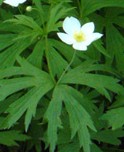 Growing in moist meadows, river floodplains, and wet ditches throughout the cool regions of the US, meadow anemone produces white, upward facing flowers two inches across on hairy stems arising from a clump of deeply-dissected leaves with three to five lobes.
Growing in moist meadows, river floodplains, and wet ditches throughout the cool regions of the US, meadow anemone produces white, upward facing flowers two inches across on hairy stems arising from a clump of deeply-dissected leaves with three to five lobes.
Height: 1-2’
Light: Full sun to part shade
Soil: Wet to moist
Hardiness: Zones 3-8
Jack in the Pulpit (Arisaema triphyllum)
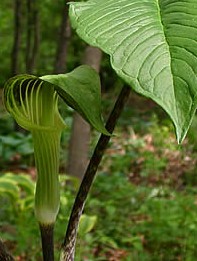 Native to woodlands and forests of eastern US, Jack in the pulpit has a unique flower structure consisting of a spadix surrounded by a spathe. The erect spadix holds many tiny, green to purple flowers while the green or purple spathe wraps around the spadix and forms a hood above it. The two large leaves are divided into three leaflets and form a canopy above the flower structures.
Native to woodlands and forests of eastern US, Jack in the pulpit has a unique flower structure consisting of a spadix surrounded by a spathe. The erect spadix holds many tiny, green to purple flowers while the green or purple spathe wraps around the spadix and forms a hood above it. The two large leaves are divided into three leaflets and form a canopy above the flower structures.
Height: 8-24
Light: Part to full shade
Soil: Wet, moist
Hardiness: Zones 4-9
Marsh Marigold (Caltha palustris)
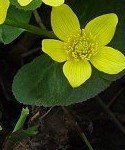 Growing in marshes, and wet woodland and meadows of northern US, marsh marigold has bright yellow flowers one inch across carried on branched stems above the foliage in terminal or auxiliary clusters. The glossy leaves are round to heart-shaped, seven inches across, and are carried on long petioles.
Growing in marshes, and wet woodland and meadows of northern US, marsh marigold has bright yellow flowers one inch across carried on branched stems above the foliage in terminal or auxiliary clusters. The glossy leaves are round to heart-shaped, seven inches across, and are carried on long petioles.
Height: 12-18”
Light: Sun to part shade
Soil: Wet
Hardiness: Zones 1-7
Purple Meadow Rue (Thalictrum dasycarpum)
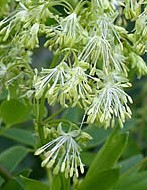 This clump-forming rhizomatous perennial is native to most of the US where it grows in swamps, lake edges and prairies. The small white flowers are tinged with purple and appear in late spring in terminal panicles. The fine-textured foliage is compound and resembles that of columbine.
This clump-forming rhizomatous perennial is native to most of the US where it grows in swamps, lake edges and prairies. The small white flowers are tinged with purple and appear in late spring in terminal panicles. The fine-textured foliage is compound and resembles that of columbine.
Height: 3-5’
Light: Prefers dappled shade but tolerates full sun if moisture sufficient and temperatures cool.
Soil: Moist, wet
Hardiness: Zones 4-7
Golden Alexander (Zizia aurea)
 Golden Alexander is native to the eastern half of the US where it grows in prairies, woodlands, savanna, thickets, glades, clearing, abandoned fields, and wet meadows. The tiny yellow flowers appear in flat-topped, compound umbels; the leaves are doubly compounded with three toothed leaflets.
Golden Alexander is native to the eastern half of the US where it grows in prairies, woodlands, savanna, thickets, glades, clearing, abandoned fields, and wet meadows. The tiny yellow flowers appear in flat-topped, compound umbels; the leaves are doubly compounded with three toothed leaflets.
Height: 18-36”
Light: Full sun to part shade
Soil: moist to wet
Hardiness: Zones 3-8